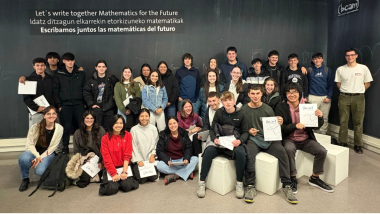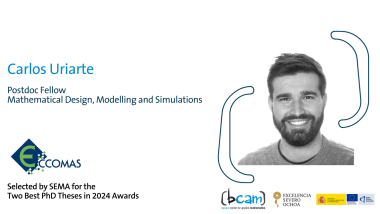Daniel Molina will defend his doctoral thesis on Thursday, October 24th
- The defense will take place at the “Salón de Grados” of the Faculty of Science and Technology of the UPV/EHU, at 10:00 am
Daniel Molina holds a Bachelor’s degree in Physics (2013) and a Master’s degree in Physics and Mathematics (2014), specialized in Biomathematics, both from University of Granada.
He joined the Basque Center for Applied Mathematics in 2014 as a PhD student (Predoc Severo Ochoa 2015) and his thesis has been supervised by Ikerbasque Research Associate Gianni Pagnini, leader of the Statistical Physics research line at BCAM. O
n behalf of all BCAM members, we would like to wish Daniel the best of luck in his upcoming thesis defense.
PhD thesis Title: Stochastic Processes for Anomalous Diffusion
Anomalous diffusion is a diffusion process which Mean Square Displacement (MSD) is not a linear funtion of time, what is known as normal diffusion. When the relation is faster than linear, it is called superdiffusion and when it is slower, subdiffusion. Physically, the MSD is a measure of the deviation of the position of the particles over time. It can be thought as the amount of space the particles have explored in the system. On the one hand, anomalous diffusion has been shown to appear extensively in nature and, consecuently, scientists have developed several and different models that can effectively reproduce it. However, the underlying physics of a plethora of experiments is still not well-understood. This is the case of the motion of mRNA molecules inside living E. coli cells, where stochastic processes as the continuous-time random walk can explain non-ergodicity but an alternative like the fractional Brownian motion is needed to reproduce p-variation. We find that a family of stochastic processes known as generalised grey Brownian motion can fit correctly that observation. In addition, we also use an explicit time-dependent factor to model non-stationarity, usually referred to aging in the specialized literature. In agreement with our computational results, we were able to obtain analytical expressions for a list of observables too, including temporal and ensemble-average MSD, Ergodicity Breaking parameter, one-point one-time probability density function and p-variation. On the other hand, many experiments show a characteristic crossover from anomalous to normal diffusion. For example, it happens in viscoelastic systems such as the motion of lipid molecules in lipid bilayer membranes We studied the motion of particles driven by tempered fractional Gaussian noise which power-law correlations present a cutoff at some mesoscopic time scale. Deriving analytical expressions of the MSD for the overdamped Langevin equation and the fractional Langevin equation, we find that when the truncation is strongly done, the mentioned crossover appears. When the truncation is done by a weak power-law truncation, we also got a different crossover behaviour from faster to slower superdiffusion and from slower to faster subdiffusion. We were also interested in another process defined through a tempering directly done in the fractional Brownion motion definition. It is known as tempered fractional Brownian motion and, surprisingly, it does not arrive to the same behaviours than our models. Instead, at long times it exhibits localization as Ornstein-Uhlenbeck. We compare both of them. When the derivative of this tempered fractional Brownian motion is used in the fractional Langevin equation, it leads to ballistic diffusion at long times. In the last part, we were interested in the state of the art in spatial neutral theory of Ecology, which problems sound familiar to experts in Statistical Physics. In fact, ecosystems display a complex spatial organization that ecologists have tried to characterize by observing patterns of biodiversity at different spatial scales. Linking those measures with the causes that originate them is arguably the central problem in Ecology. Ecological neutral theory, which underscores the role of stochastic demographic fluctuations and neglects deterministic effects stemming from fitness differences, has predicted the empirical patterns in communities of competing species. We study non-trivial scaling laws arising at the critical dimension (2D) of spatial neutral models, which are poorly understood. We conclude by discussing models that support non-neutral features.
Related news
About the center
About the center




